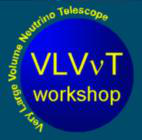Orateur
Dr
Christian Joram
(CERN / PH Department)
Description
The concept of hybrid photodetectors which combine a large area photocathode with a crystal scintillator anode in the centre of a hemispherical vacuum tube was demonstrated first with the Philips SMART tubes and, more recently, with the QUASAR tubes of the Lake Baikal experiment. Photoelectrons from the cathode are accelerated by a potential difference of 20-30 kV and deposit their kinetic energy in the scintillator / Phosphor. The generated scintillation light is detected by a small and low cost photodetector, e.g. a conventional PMT. The X-HPD study is a variation of this concept aiming at improved performance and maximum simplicity. The glass envelope is essentially spherical and a spatial scintillator crystal is mounted in its centre. The spherical symmetry leads to a uniform collection efficiency and very small intrinsic time spread over the full viewing angle of 120˚ (3 pi solid angle). The amplification mechanism by means of the scintillator leads to a distinct single electron response and limited photon counting capability. A welcome side effect is the double-cathode phenomenon. Light traversing the photocathode without conversion has a second chance to be detected on the opposite side, resulting in almost double quantum efficiency. We report about test results of a first X-HPD of 208 mm diameter with a cylindrical LYSO crystal. A second tube with improved electrostatical properties is in prepration at CERN and will be tested in the coming weeks.
Auteur
Dr
Christian Joram
(CERN / PH Department)

